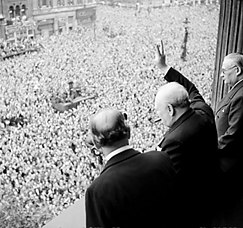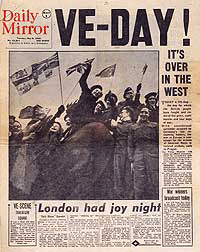Victory in Europe Day, generally known as V-E Day, VE Day, or simply V Day was the public holiday celebrated on 8 May 1945 (7 May in Commonwealth realms) to mark the formal acceptance by the Allies of World War II of Nazi Germany's unconditional surrender of its armed forces. It thus marked the end of World War II in Europe.
On 30 April, Adolf Hitler, the Nazi leader, committed suicide during the Battle of Berlin. Germany's surrender, therefore, was authorized by his successor, Reichspräsident Karl Dönitz. The administration headed by Dönitz was known as the Flensburg government. The act of military surrender was signed on 7 May in Reims, France and on 8 May in Berlin, Germany.
Celebrations

Upon the defeat of Germany (Italy having already surrendered), celebrations erupted throughout the world. From Moscow to Los Angeles, people cheered. In the United Kingdom, more than one million people celebrated in the streets to mark the end of the European part of the war. In London, crowds massed in Trafalgar Square and up The Mall to Buckingham Palace, where King George VI and Queen Elizabeth, accompanied by Prime Minister Winston Churchill, appeared on the balcony of the Palace before the cheering crowds. Princess Elizabeth (the future Queen Elizabeth II) and her sister Princess Margaret were allowed to wander incognito among the crowds and take part in the celebrations.
In the United States, the victory happened on President Harry Truman's 61st birthday. He dedicated the victory to the memory of his predecessor, Franklin D. Roosevelt, who had died of a cerebral hemorrhage less than a month earlier, on 12 April. Flags remained at half-mast for the remainder of the 30-day mourning period. Truman said of dedicating the victory to Roosevelt's memory and keeping the flags at half-mast that his only wish was "that Franklin D. Roosevelt had lived to witness this day." Later that day, Truman said that the victory made it his most enjoyable birthday.
Massive celebrations also took place in Chicago, Los Angeles, Miami, and especially in New York City's Times Square.
Soviet Victory Day

As the Soviet representative in Reims had no authority to sign the German instrument of surrender, the Soviet leadership proposed to consider Reims surrender as a "preliminary" act. The surrender ceremony was repeated in Berlin on May 8, where the instrument of surrender was signed by supreme German military commander Wilhelm Keitel, by Georgy Zhukov and Allied representatives. Since the Soviet Union was to the east of Germany, it was 9 May Moscow Time when the German military surrender became effective, which is why Russia and most of the former Soviet republics commemorate Victory Day on 9 May instead of 8 May.
Commemorative public holidays

(May 8 unless otherwise stated)
- United Kingdom - 1995 May Day Bank Holiday was moved from the first Monday in May, May 1, to Monday 8 May, for that year only, to commemorate the 50th anniversary of the ending of the Second World War.
- East Germany as Tag der Befreiung (Day of Liberation), a public holiday from 1950 to 1966 and in 1985. Between 1975 and 1990, as Tag des Sieges (Victory Day (May 9)).
- France as Victoire 1945
- Slovakia as Deň vÃÅ¥azstva nad faÅ¡izmom (Victory over Fascism Day)
- Czech Republic as Den vÃtÄ›zstvà (Day of Victory) or Den osvobozenà (Day of Liberation)
- Poland as "Dzień Zwycięstwa" (Day of Victory)
- Norway as "Frigjøringsdagen" (Liberation Day) (8 May)
- Denmark (5 May) as "Befrielsen" (The Liberation)
- Netherlands (5 May) as "Bevrijdingsdag" (Liberation Day)
- Ukraine (8 â€" 9 May) "Ð"ень Пам'ÑÑ‚Ñ–" (Memorial Day)
- Belarus (9 May) "Ð"зень Перамогі" (Victory Day)
- Russia (9 May) "Ð"ень победы" (Victory Day)
- Kazakhstan (9 May) as "Ð–ÐµÒ£Ñ–Ñ ÐºÒ¯Ð½Ñ–" or "Ð"ень победы" (Victory Day)
- British Channel Islands Liberation Days: Jersey and Guernsey (9 May), Sark (10 May)
- Italy (25 April) "Festa della Liberazione" (Liberation Holiday). Milan was freed from the Nazi troops on 25 April 1945.






0 comments:
Post a Comment